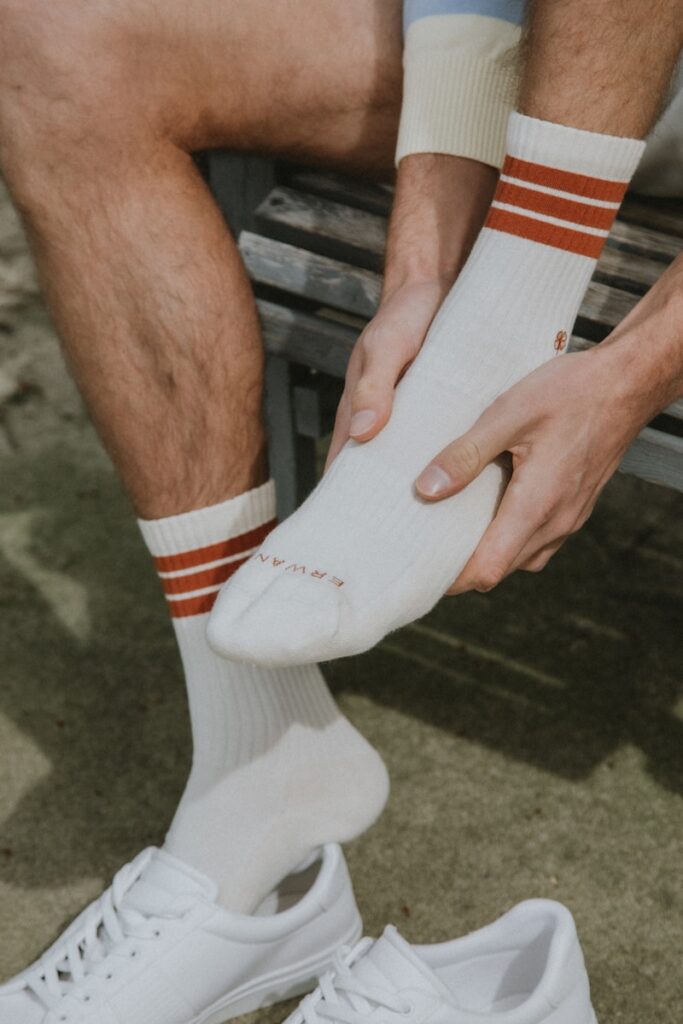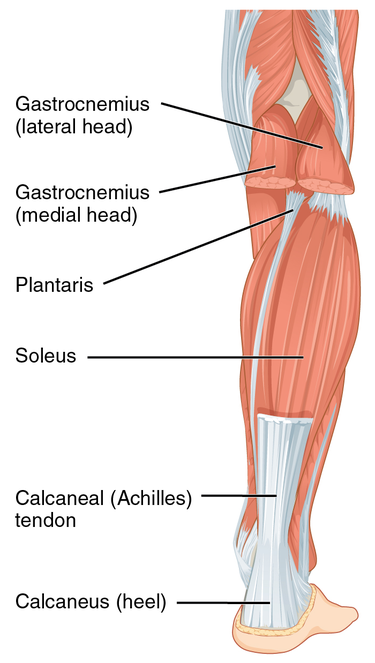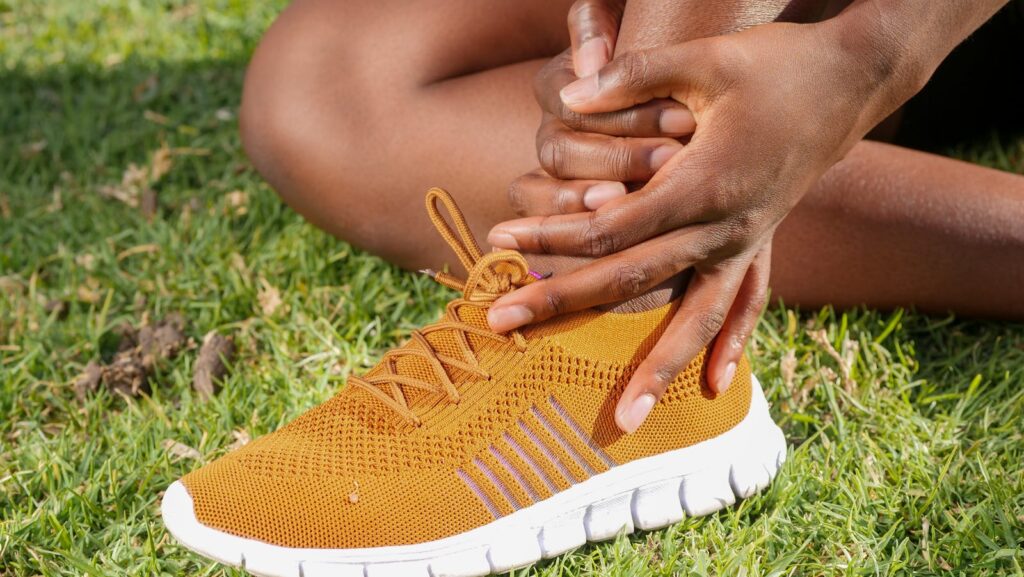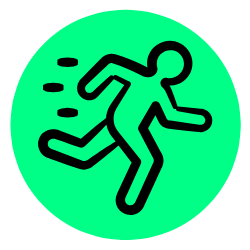While running offers amazing physical and mental benefits, there is still a very high risk of injury for beginners. These injuries may cut their running journeys short, but prevention is possible. It is important to prevent and be aware of these common injuries so that you can enjoy your running experience. Likewise, we will be exploring common running injuries and how to treat or prevent them.
Here are some common running injuries:
1. Runner’s knee (Patellofemoral Syndrome)
This is a common overuse injury and occurs when the kneecap is out of alignment (sometimes known as Patellofemoral syndrome). The cartilage (flexible, connective tissue) around the knee can wear down with use early on and it is important to slowly adjust into running. It can even happen from various other activities and is one of the most common causes of knee pain.
Someone with runner’s knee may feel pain around the kneecap when climbing stairs or sitting in a position when the knee is bent. A popping or crackling sound in the knee is a common sign of runner’s knee.
For treatment, you can use medical tape around the knee to allow stability. You can also try resting till your knee feels better. If conditions do not improve, you may need to see a doctor for assistance. You could also try modifying your activities or utilize knee and hip exercises. I have learned that stretches allow for prevention of injuries and quicker recovery.
2. Stress fracture injury

A small crack in a bone that could cause severe pain. Stress fractures in runners usually affect new runners in their shins or feet. This is because there are many 26 bones in each foot, exposing them to more stress when running.
The pain can get worse when doing other activities, but could improve a lot with rest. You should take a break from running if you feel that you are experiencing a stress fracture and visit a doctor. Rest can also prevent the stress fracture from turning into a more serious injury and speed up recovery.
You can also refer to the R.I.C.E method of treatment for best results (see number 5 on this list).
3. One of the most common injuries: Shin splints
This is a very common injury that creates pain in the front or inside of the lower leg along the shin bone. Shin splints usually occur when a person changes their workout too quickly (such as increasing mileage too quickly or doing more speed workouts).
The pain may be similar to a stress fracture, but pain from the shin splint spreads across the entire bone. However, this fact should not be used for self-diagnosis. An X-ray is commonly used to determine whether it is one or the other. People who have flat feet are more likely to develop this, but can affect anyone.
For treatment, reducing mileage, try slowing your pace, and regular stretching exercises would be helpful to treat shin splints. It is recommended to ice your shins for a few minutes every day.
I myself had this injury when I started running and it was painful to run for more than 5 minutes. I decided to rest for a couple weeks and I found that icing your shins everyday for 15 minutes a day makes the healing process much quicker and stretching often also helps speed up the healing process.
4. Achilles Tendinopathy (also known as tendinitis)

Achilles Tendinopathy degeneration of the Achilles tendon. This is a large tendon that attaches to the back of the heel and the calf. It could cause pain (it usually feels like burning) and stiffness in the area of the tendon (pictured above). Achilles Tendinopathy is a very common overuse injury that new runners could face.
Achilles Tendinopathy is caused by repetitive stress to the tendon such as by adding too much mileage too quickly. Tight calf muscles can also contribute to Achilles Tendinopathy.
For treatment, a person should rest, apply ice, and calf stretches. To prevent tendinitis, a person should stretch often in the lower legs. Perform a warm up before the workout and a cooldown after finishing for the best chance to prevent tendinitis.
5. Muscle pull/muscle strain injuries
A muscle pull is a tear in a muscle (usually very small but could get worse). A person will feel a popping sensation when they pull their muscle and it commonly affects the hamstrings, quads, calves, and groin for a runner. This injury can likely lead to the end of entire seasons for high school and college runners if ignored.
People are recommended to use the R.I.C.E method of treatment – Rest, Ice, Compression, and Elevation. Rest consists of preventing activity and Ice refers to putting ice on the affected area. Compression consists of covering the affected area with medical tape to stabilize the area and lower swelling. Elevation means to prop the affected area up to (around 6 to 10 inches above the heart).
I also found that stretching is the best in preventing muscle pulls/muscle strains. Never forget your warm-ups and cool downs in your workouts!
6. Ankle Sprain Injuries

An ankle sprain is accidental over-stretching of the or tearing of the ankle ligaments. It does not come under a muscle strain as it affects the ligaments and not the muscles. This usually occurs when the foot rolls inward while running. Ankle pain may be immediate or increase, depending on how the strain occurred and the severity of the strain.
If you have an ankle sprain, you may feel that there is inflammation or redness in the area, muscle cramps or a feeling of weakness (for example, if you sprint and feel very wobbly or like you are about to fall right after), and a loss of motion (may go limp in severe cases). You should go to a doctor if you think your ankle may be broken, which is much more severe. A broken ankle would require a cast or foot.
For treatment, utilize the RICE method and to prevent it, one should stretch often and allow the body to adapt. You could also try adding ankle strengthening workouts to your rest days and prevent chances of an ankle sprain.
Try standing on one leg and writing the alphabet with the other, then switch and repeat. The alphabet ankle exercise will help strengthen your ankle and foot and prevent chances of injury. Also, pick a softer surface to run on if you need to avoid too much pressure on joints.
7. Plantar Fasciitis
Inflammation of the thick tissue in the bottom of the feet that goes from the heel to the toe. When dealing with Plantar Fasciitis, a person may experience severe heel pains, usually after running or when they wake up.
Tight calf muscles or high arch of the feet and increasing mileage are common causes leading to this condition. However this might occur without any obvious cause and can be difficult to self-diagnose. Treatment that could help this consists of stretching the calves, icing the bottom part of the foot, R.I.C.E method of treatment, and wearing good shoes and prevention of plantar fasciitis requires the same method.
8. IT band syndrome (iliotibial band)
No, this is not an injury related to your computer. The IT band is a ligament that goes along the thigh starting at the top of the hip to the outside areas of the knees and can come from various activities and not just running. You may face pain on the outside of the knee when facing this injury. This is because IT band syndrome is present when the band thickens and rubs against the knee, causing inflammation.
IT band syndrome occurs when there is knee arthritis, bowed legs, and weakness in your hip, glutes, or other muscles. For treatment of this injury, a person should cut back on exercise, stretch before and after exercise (warm up and cool down), avoid running downhill, and also ice the area when the exercise is finished. However, something to note is that you should wait a few minutes before starting to cool down. You should be aware that this action could also cause IT band syndrome.
9. Blisters
Fluid filled sacs on the surface of the skin and caused by friction between shoes or socks to the skin. You will see bumps on your foot/leg when with this injury and may feel pain when you touch them. A common area where blisters may occur is under your foot (from my own experience) and may feel very annoying.
To prevent blisters: Fit into new shoes gradually (use them one one day for 30 minutes, one day without those shoes, and the third day for 1 hour) so that the feet can adapt, wearing socks with more than 1 layer (lowers friction), and applying petroleum jelly to the areas that could have blisters.
For treatment: Cover the affected area with a bandage if it has not popped and avoid pressure in the area. If it has already popped, wash the area with warm water and some soap (do not use alcohol). Diseases may be able to directly enter your bloodstream if your blister is popped (yikes!). To prevent that from happening, try to cover the blister loosely with a sterile bandage.
10. Temperature related injuries
- From running in heat – sunburn, heat exhaustion (could lead to heat stroke)
- Running in cold weather (especially during the winter months) – Frostbite, hypothermia. Could lead to death or loss of limbs from severe cases. DO NOT push yourself to run in cold weather and plan accordingly.
To prevent possibilities, a person should dress appropriately to the weather, drink water before workouts, and use sunscreen if necessary.
More tips to prevent injuries
Listening to your body, creating an effective running plan, allowing rest days to heal all the affected muscles, performing warm ups and cool downs to stretch muscles are good ways to prevent most running injuries. Also, include strength training/cross training to ensure that all muscles are getting stronger and are less susceptible to injuries. A person should not change the running surface suddenly, overtrain, or eat unhealthy when running to further prevent chances.
Conclusion
This post only covered some of the injuries of running. People may also face back pain and hip abductor and flexor strains from running. If you feel like you are facing an injury, it is important to go to a doctor instead of self-diagnosis. It may be expensive, but it is the best way to prevent an injury from turning into something much, much worse. Even with all the effort, it may still be inevitable that you get injured someday during your running career, but do not let this bring you down. You should seek treatment and perform other exercises, if possible, to help keep your strength while healing. I hope you learned something and realized the importance of preventing common running injuries.
